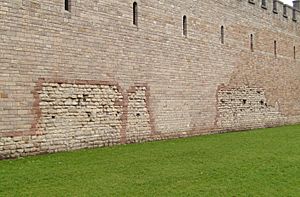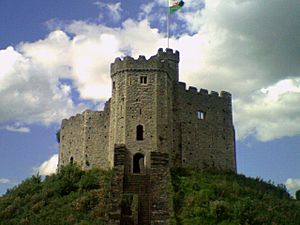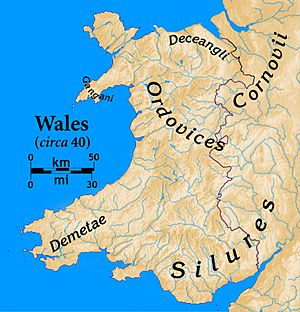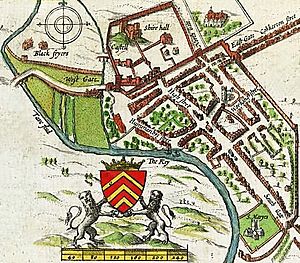History of Cardiff facts for kids
The history of Cardiff is super long, going back at least 6,000 years! This amazing city is the capital of Wales. People have lived around Cardiff since the Stone Age. You can still see ancient burial places from that time, like the St Lythans burial chamber. Later, during the Bronze Age and Iron Age, people built big mounds and hillforts here.
Before the Romans arrived, a Celtic tribe called the Silures lived in this area. They were strong and brave! The city's name, Caerdydd, comes from the Roman fort built by the River Taff. Caer means 'fort' and Taf is the river's name. This fort was built right over an older settlement made by the Silures in the 50s AD.
Contents
Early People in Cardiff

After the last ice age ended, about 12,000 to 10,000 years ago, Mesolithic hunter-gatherers started moving north. The land that is now Wales became free of ice. Back then, sea levels were much lower. Great Britain was actually connected to Europe by a land bridge called Doggerland! But as the ice melted, the sea rose, creating the Irish Sea and turning Great Britain into an island.
Later, people came to Wales by boat from places like Spain and Portugal. These Neolithic settlers joined the people already living here. They slowly changed from hunting and gathering to farming. They cleared forests to grow crops and raise animals. They also brought new skills like making pottery and weaving cloth. These early farmers built large stone tombs, like the ones you can still see today.
Archaeologists have found proof that these Neolithic people settled around Cardiff about 6,000 years ago. This was long before famous places like Stonehenge or the Great Pyramid of Giza were built! Some of these ancient sites include:
- The St Lythans burial chamber near Wenvoe.
- The Tinkinswood burial chamber near St. Nicholas.
- The Cae'rarfau Chambered Tomb in Creigiau.
Over many centuries, new groups of people arrived, bringing ideas from the Bronze Age and Iron Age. The area around Cardiff became home to the Celtic Silures tribe. They also lived in parts of what is now Breconshire, Monmouthshire, and the rest of Glamorgan. You can find Bronze Age burial mounds on Garth Hill in the north of Cardiff. Several Iron Age hillforts have also been found, including Caerau Hillfort.
The Roman army invaded Great Britain in 43 AD. The Silures tribe bravely fought back against the Romans. They even defeated a Roman army in 52 AD! Because of this, the area that would become Cardiff stayed free from Roman control for a while.
Archaeological finds show that the Silures had a large settlement in central Cardiff in the 50s AD. It had big timber buildings. The Romans later built their fort right on top of this important Silures settlement.
Roman Times in Cardiff

Roman soldiers arrived in the Cardiff area as early as 54–68 AD, during the time of Emperor Nero. They eventually defeated the Silures tribe. The Romans then built their first fort in a very important spot. It was where the River Taff and River Ely meet the Bristol Channel. This first fort was about 10 acres and had wooden barracks, storage, and workshops.
Around 75 AD, the Romans finally took control of all of Wales. The Roman fort in Cardiff was rebuilt, a bit smaller this time. Around 250 AD, another fort was built with strong stone walls that were 10 feet thick. It also had an earth bank to help protect against attacks. The Roman army used this fort until they left Britain in the early 5th century.
Vikings and the Middle Ages
Not much is known about Cardiff right after the Romans left. It's thought that raiders might have attacked the area often, making it hard to live there. The first time Cardiff is mentioned in writing is in 445 AD.
Around 850 AD, the Vikings started attacking the Welsh coast. They used Cardiff as a base and later as a port for their ships. Some street names in Cardiff, like Womanby Street, come from the Vikings!
In 1091, a Norman lord named Robert Fitzhamon started building a castle keep inside the old Roman fort walls. By 1111, Cardiff town walls were also built. Cardiff Castle has been at the heart of the city ever since. Soon, a small town grew up around the castle, mostly with settlers from England. In the Middle Ages, Cardiff had about 1,500 to 2,000 people, which was a normal size for a Welsh town back then.
Robert Fitzhamon's daughter married Robert, 1st Earl of Gloucester. He built the first stone keep at Cardiff Castle. He even used it to imprison Robert II, Duke of Normandy for many years! During this time, the first Mayor of Cardiff, Ralph "Prepositus de Kardi," took office.
Between 1158 and 1316, Cardiff was attacked several times. Welsh leaders like Ifor Bach and Llywelyn Bren attacked the castle as part of revolts.
By the late 1200s, Cardiff was the only town in Wales with over 2,000 people. It had a busy port and became a "Staple port" in 1327, which meant it was an important trading hub. The town also had weekly markets and two yearly fairs, bringing traders from all over Glamorgan.
In 1404, the famous Welsh rebel Owain Glyndŵr burned Cardiff and took Cardiff Castle. Since most buildings were made of wood, the town was destroyed. But Cardiff was rebuilt quickly and began to grow again.
Cardiff Becomes a County Town
In 1536, the Act of Union joined England and Wales. This created the county of Glamorgan, and Cardiff was made its county town. Around this time, the Herbert family became very powerful in the area. In 1538, Henry VIII closed down the friaries (religious houses) in Cardiff. Their stones were used to build other things.
A writer from that time described Cardiff as having a "fair quay and a safe harbour for shipping." In 1542, Cardiff got to send its own representative to the House of Commons for the first time. In 1581, Elizabeth I gave Cardiff its first royal charter, which gave the town special rights.
By 1602, one historian called Cardiff "the fayrest towne in Wales." Cardiff got another Royal Charter in 1608. During the Second English Civil War, a big battle happened near Cardiff, at St. Fagans. This battle was a huge win for the Parliamentarians and helped Oliver Cromwell take control of Wales. It was the last major battle in Wales.
For the next century, Cardiff was peaceful. In 1766, John Stuart, 1st Marquess of Bute married into the Herbert family. He later became Baron Cardiff and started fixing up Cardiff Castle in 1778. By the 1790s, Cardiff had a race track, a printing press, a bank, and even a coffee room. It also got a stagecoach service to London.
Despite these changes, Cardiff was not a very big town. In 1801, its population was only 1,870 people. It was much smaller than other Welsh towns like Merthyr Tydfil and Swansea.
Building the Docks and Modern Cardiff
In 1793, John Crichton-Stuart, 2nd Marquess of Bute was born. He would become known as "the creator of modern Cardiff" because he spent his life building the Cardiff docks. In 1815, a boat service started between Cardiff and Bristol.
Cardiff grew very fast from the 1830s onwards. This was because the Marquess of Bute built a dock that connected to the Taff Vale Railway. Cardiff became the main port for exporting coal from the nearby valleys like Rhondda. The town's population grew by almost 80% every ten years between 1840 and 1870! Many people moved to Cardiff from other parts of Wales and even from Ireland. By 1881, Cardiff was the largest town in Wales, bigger than Merthyr and Swansea.
Cardiff's importance grew even more when the University College South Wales and Monmouthshire was built there in 1893.
In the 1880s, new docks were built in Barry, which was a challenge for Cardiff. Barry docks were easier for ships to use at all tides. But Cardiff remained the centre for the coal trade. The Coal Exchange in Cardiff was where the price of coal for Britain was decided. The city also got stronger in industry when a new steelworks was built near the docks in 1890.
City and Capital Status
Edward VII made Cardiff a city on October 28, 1905. It also got a Roman Catholic Cathedral in 1916. Over the years, more national buildings came to Cardiff, like the National Museum of Wales and the University of Wales registry.
After a short boom, the Cardiff docks started to decline between the two World Wars. By 1936, their trade was less than half of what it was in 1913, because there was less demand for Welsh coal. During the Cardiff Blitz in World War II, bombs damaged parts of the city, including Llandaff Cathedral.
Cardiff was officially named the capital city of Wales on December 20, 1955. Caernarfon had also wanted this title. So, Cardiff celebrated two big anniversaries in 2005! Even though Cardiff hosted the Commonwealth Games in 1958, it only truly became a centre for national government when the Welsh Office was set up in 1964. This led to other important Welsh organizations being based in Cardiff.
The East Moors Steelworks closed in 1978, and Cardiff's population went down in the 1980s. But it soon recovered and was one of the few cities (outside London) that grew in the 1990s. During this time, the Cardiff Bay Development Corporation worked to improve south Cardiff. This project really helped make Cardiff a better and more beautiful place.
In 1999, people in Wales voted on whether to have a National Assembly for Wales (now called the Senedd). Cardiff voters actually said no to it at first. But the Assembly still ended up in Cardiff Bay in 1999. In 2005, a new building for the Assembly, designed by Richard Rogers, was opened.
Cardiff was the county town of Glamorgan until 1974. Then, in 1996, Cardiff became its own special area called the City and County of Cardiff. On March 1, 2004, Cardiff was given Fairtrade City status, meaning it supports fair trade.








